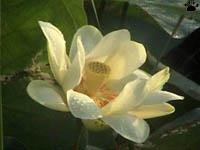
Yellow lotus (Nelumbo lutea), Virginia
Wild, Wild East - Part 2
The most under-appreciated part of Eastern North America is the Deep South,
which is actually the northern coast of the Gulf of Mexico, Northern Florida,
and the Atlantic Coast from.Georgia to North Carolina. This
is the land of unique forests, formed by an ancient tree called baldcypress
(Taxodium distichum). It grows on low coasts, floodplains and swamps.
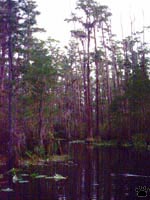
Cypress swamp,
Atchafalaya River, Louisiana |
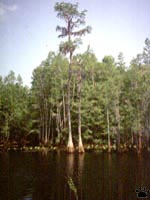
Cypress swamp,
Okefenokee Swamp, Georgia |
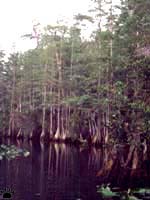
Cypress swamp,
Dismal Swamp, North Carolina |
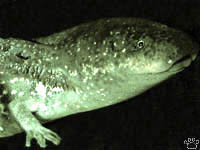
Greater siren (Siren lacertina),
Loxahatchee NWR, Florida. |
Cypress forests are usually flooded
or crisscrossed by slow blackwater bayous. Ancient eel-like creatures hide in
cool sleepy waters - sirens and amphiumas, giant salamanders which look and behave
almost exactly like lungfishes of other continents. |
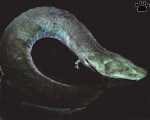
Two-toed amphiuma (Amphiuma means),
Atchafalaya River, Louisiana |
| For a devoted naturalist, a trip through endless
cypress forests is one of the most awarding experiences on Earth. In summer they
are guarded by swarms of gnats and mosquitoes, so this Mesozoic paradise doesn't
attract many people. Inner areas of large cypress swamps are so little visited
that nobody knows for sure what exactly lives there. A small remaining population
of mountain lions (Felis concolor) in Louisiana was considered a local
myth for decades. Another ghost of the swamps is ivory-billed woodpecker (Campephilus
principalis), considered extinct for 50 years, but probably still present
in some remote areas. It is hard to believe that almost all cypress forests are
secondary: they have all been logged many decades ago. The best way to explore
them is by boat or swimming. |

Water lily (Nymphea
odorata), Suwannee
River, Florida.
|

American alligator
(Alligator mississipiensis),
Matagorda Island, Texas |

Armadillo (Dasypus
novemcinctus),San
Marcos River, Texas |
Alligator, the top predator of swamps, feeds on everything
from snails to armadillos. Some amazing facts of its biology have only recently
been discovered: these reptiles can communicate by infrasound and modify landscape
by "gator hole" construction. |
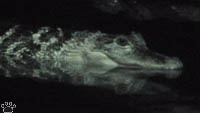
Alligators are mostly nocturnal.
Flamingo, Florida. |

Copperhead, Congaree Swamp,
South Carolina. |
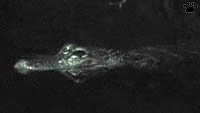
Young alligator.
Flamingo, Florida. |

Scarlet snake,
Mayo, Florida |
Scarlet snake (Cemophora coccinea), Eastern
diamondback rattlesnake (Crotalus adamanteus), and copperhead (Agkistrodon
contortrix) are among the most beautiful inhabitants of cypress forests. There
are few dozen species of snakes in the Southeast. The best way to see them is
to drive on remote blacktop roads in warm summer nights. |

Rattlesnake,
Perry, Florida |
| Swamps of Everglades in Florida form the transitional
zone to the tropics of the Caribbean. Some tropical species invade freshwater
marshes and pine forests, but most stay in hardwood hammocks and coastal mangroves.
Few northerners have made it to the coast and offshore islands. Florida Keys,
limestone islands off South Florida, have once been connected to the mainland,
so many terrestrial animals have colonized them. The white-tailed deer of the
Keys have become a dwarf race (Odocoileus virginianus clavium). |

Key deer,
Florida Keys. |
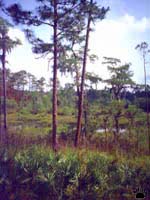
Pine-palmetto forest,
Bioxi, Mississippi |

Recent burn,
Ocala, Florida |
Uplands and inland parts of the Southeastern coast
are covered with wonderful pine forests. More dry of them look not unlike subarctic
pine taiga of Scandinavia: low, open, with dense layer of lichens on the
forest floor. But in relatively wet areas, there is a dense undergrowth of tiny
palmetto (Sabal) palms, that looks a bit weird in otherwise northern-style
surroundings. |
| Like many other pine forests around the world, it
is a fire-dependent ecosystem, but this one seems to be particularly fire-adapted.
Some native insects are attracted to smoke as they only breed in recently burned
wood. |

Forest fire, Texas. |

Racerunner (Cnemidophorus sexlineatus),
Milton, Florida |
The Great Pine Belt stretches across the Southeast,
and, like cypress swamps, is blessed by high diversity of flora and fauna. Racerunner
is among its most common inhabitants, while red wolf, Houston toad and Venus'
trap are among the rariest. |
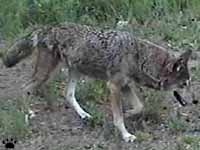
Red wolf (Canis rufus), Bull Island,
South Carolina. |

Houston Toad (Bufo houstonensis),
Bastorp State Park, Texas. |

Venus' trap (Dionaea muscipula),
Lake Waccamaw, South Carolina. |
| Most local pines have long needles. Young trees of
some species have the longest needles of all conifers in the world. These cute
babies look more like tiny bunches of long, soft grass than pines. As they grow,
"tussocks" leave the ground and soon become fluffy crowns on short trunks.
Only when they reach 2-3 m (6-10'), they start resembling "normal" pine
trees, but are still soft and very pettable. The largest of 13 Eastern pine species
is the magnificent white pine, which grows north from The Great Pine Belt. |
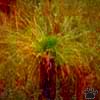
Baby longleaf pine
(Pinus longifolia),
Big Thicket, Texas |
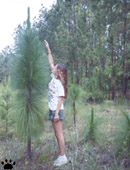
Young pond pine (P. serotina),
Francis Marion National Forest,
South Carolina. |
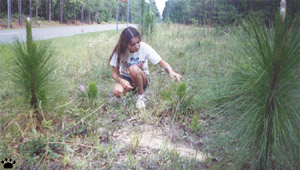
Baby loblolly pines (P. taeda),
Croatan National Forest,
North Carolina. |
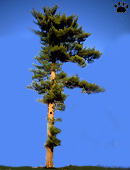
Eastern white pine (P. strobus),
Hiawatha National Forest,
Michigan. |
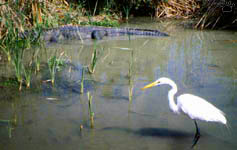
Great egret and alligator, Mustang Island, Texas
Part 3. The Mountains
Back to Part 1
Home
|